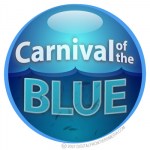marine life
Researchers observed tiny voids forming in silicon used for solar panels; these voids provide physical evidence of the Staebler-Wronski effect, "which reduces the solar cell efficiency by up to 15 percent within the first 1000 hours."
Using an online avatar with a skin color other than your own makes you less racist in real life; playing a hero makes you less cruel, and playing a villain less benevolent.
Old mouse muscles exhibit "elevated levels of activity in a biological cascade called the p38 MAP kinase pathway" which prevents stem cells from dividing and repairing muscle damage. By…
So, you may have heard this rumor that I, on occasion, do things other than blog, tweet, or facebook. It may seem shocking, but I do have a day job (if you can call it that - a graduate student's job never seems to be restricted by sunlight).
For the past couple weeks, I've been getting my butt kicked into super shape by an intense 2-week scientific diver certification course, which covers from open water to master scuba diver at warp speed. It was intense, physically exhausting, and mentally draining. But it was well worth it, because now, I can do something even more intense, physically…
tags: Oil From BP Leak Threatens Life on a Nearby Seamount, animals, marine life, fishes, invertebrates, Salt Dome Seamount, oil drilling, oil spill, oil wells, petroleum, BP, British Petroleum, TransOcean, environment, streaming video
In 2002, ocean explorer Gale Mead was the first person to see and film the profusion of life 200 feet down on Salt Dome Seamount -- just 16 miles from where the BP oil well is now gushing out of control. Mead (daughter of oceanographer Sylvia Earle) describes the corals and fish she saw and the devastation that the oil is likely causing in a place that no other…
Ahoy mates, and welcome aboard the 36th edition of the Carnival of the Blue!
The Oceans as a whole:
As many of you might know, CITES had its once-every-three-years meeting during which it decides which organisms are to be regulated and how. As Rick MacPherson explains, the overall message was simple: FU, Ocean. He takes a closer look at the CITES listing process and digs a little deeper into the "secret ballots."
Maybe CITES will take note if the world made it clear that oceans matter. There's no better time than now to take Oceana's Ocean Pledge. If you do, $1 will be donated to Oceana to…
tags: Life in the Aphotic Zone, animals, marine life, marine biology, bioluminescence, benthic zone, abyssal zone, streaming video
This fascinating video captures a glimpse of the weird and wonderful animals that live in the aphotic zone. The aphotic zone (aphotic from Greek prefix á¼- + Ïá¿¶Ï "without light") is the portion of a lake or ocean where there is little or no sunlight. It is formally defined as the depths beyond which less than 1% of sunlight penetrates. Consequently, bioluminescence is essentially the only light found in this zone. Most food comes from dead organisms sinking to…
The news from the Gulf of Mexico oil spill is not good. If the NOAA estimates are right about the size of the spill it could dwarf Exxon Valdez:
Over the last few days, estimates had held that the Gulf of Mexico oil spilling was leaking about 1,000 barrels, or 42,000 gallons, into the water each day--bad, but still not historically bad on a scale like the spill caused by the Exxon Valdez. Except now, after closer investigation, the National Oceanic and Atmospheric Administration says that oil company BP's estimate might in fact be five times too low.
Rear Adm. Mary Landry, the Coast Guard's…
tags: Glowing Life in an Underwater World, marine biology, bioluminescence, luciferase, luciferin, green fluorescent protein, eye-in-the-sea cam, ethology, evolution, Edith Widder, TEDTalks, streaming video
Some 80 to 90 percent of undersea creatures make light -- and we know very little about how or why. Bioluminescence expert Edith Widder explores this glowing, sparkling, luminous world, sharing glorious images and insight into the unseen depths (and brights) of the ocean.
TEDTalks is a daily video podcast of the best talks and performances from the TED Conference, where the world's…
When we think about the vast diversity of life in the ocean, we automatically picture pristine coral reefs teeming with life. This is especially true for rich, tropical locations like Hawaii. What we don't think of are the deep, dark depths of the canyons that lie just beyond the shallow paradises we know and love. Scientists have known for years that these deep water locations may contain a wide variety of species, but don't talk about them as much because no one had ever explored them to see what species lived there. Now, thanks to researchers from the University of Hawaii's School of Ocean…
World Water Day may have come and gone, but ScienceBloggers re still searching the depths of the oceans and the rivers of tropical islands for great new research. Today, Nick Anthis of The Scientific Activist points to the discovery of the first truly anaerobic animal. These microscopic creatures don't need oxygen to make their home at bottom of the Mediterranean, so you'd be forgiven for thinking they're from another planet. For aquatic life in more familiar territory, Christine Wilcox of Observations of a Nerd follows up on a post she made in January about how farming Tilapia in Fiji puts…
Crinoids, a class of marine animals in the phylum Echinodermata, are pretty creatures. The photo at right shows a crinoid perched on a Malaysian reef with its fluffy arms extended for feeding. Looking at the photo, it's easy to see how they acquired their common name, Feather Stars.
This is how divers usually see crinoids, and this is how they are most often photographed. As pretty as crinoids are -- and they come in a vast array of colors -- photographs of the whole animal don't reveal much about the animal's structure or behavior. Whole-animal photos of creatures like this should be…
I was asked recently to write a guest posting for the Reeftank as part of their effort to grow a scientifically minded audience. Not really having any extra time, (newborns will do that to you!) I offered and they accepted a recycling of a previous posting from October last year.
It is called "The other CO2 problem" and they published it here.
The more geoengineering discussions creep into the mainstream dialogue, the more critical it is to remember this issue.
(original posting can be found here)
tags: The Blue Planet, marine life, evolution, streaming video
Thanks to one of my readers who wishes to remain anonymous, I have the great pleasure to own this fascinating BBC documentary, The Blue Planet [Amazon: $38.99], about those amazing creatures that live thousands of feet beneath the waves. I think you would love this series as much as I do. Narrated by the amazing David Attenborough [8:21]
tags: The Blue Planet, marine life, evolution, streaming video
Thanks to one of my readers who wishes to remain anonymous, I have the great pleasure to own this fascinating BBC documentary, The Blue Planet [Amazon: $38.99], about those amazing creatures that live thousands of feet beneath the waves. I think you would love this series as much as I do. Narrated by the amazing David Attenborough [10:17]
tags: Satomi's pygmy seahorse, Indonesian wildlife, Stephen Wong, Takako Uno, image of the day
Satomi's pygmy seahorse, endemic to Indonesia, is one of the world's tiniest seahorses. Two adults would fit head-to-head across the face of a penny and their offspring are each about the size of a 12-point apostrophe.
Image: Stephen Wong and Takako Uno/National Geographic.
At under half an inch tall (13 millimeters), Satomi's pygmy seahorse -- named after dive guide Satomi Onishi -- is a strong contender for the world's smallest seahorse. With their tails stretched out straight, two Satomi's…
tags: film, iMax, marine life, nature, movie trailer, streaming video
Thanks to the wonder of the blogosphere, I have been invited to a screening of the new film, Under the Sea 3D on 4 February 2009 -- below the fold is an interesting interview with the filmmakers along with a teaser for you to enjoy .. By the way, do I have any NYC readers who would like to come along? It is at 7pm on 4 February and I am allowed one guest .. (creeps need not apply) [2:53]
Tell me more!
tags: nature, oceanography, marine life, sardines, South Africa, streaming video
I watched this film a couple days ago when I visited the AMNH, and then a reader and friend found this video on youtube -- so of course, I had to share it with you! [3:33]
While Wild Ocean explores the causes and effects of man's impact, it an inspirational film looking toward a bright future, taking audiences to a rare unspoiled marine wilderness to glimpse what the oceans of the world once looked like. The film champions the creation of marine reserves necessary to bring our oceans back to life. South Africa…
On Tuesday, President Bush garnered favor with marine conservationists in a last-minute move to protect over 195,000 square miles of the Pacific Ocean—more than any president in history. The new marine reserve, which includes parts of the Mariana Trench in addition to several coral reefs and atolls, will be protected from mining, fishing, oil exploration and other destructive activities. ScienceBlogger James Hrynyshyn celebrated Bush's decision, but reminded, "By failing to accept the reality of climate change...he will more likely be remembered as the president who missed the boat."
tags: Galapagos, marine life, sharks, sea turtle, streaming video
This stunning video documents the undersea life of the Galapagos Islands -- and just when you think it can't get any better, the whale shark appears .. Music by Hans Zimmer [7:10]
Galapagos from Darek Sepiolo.
tags: fiddler crabs, marine life, photography, Image of the Day
Fiddler crabs, photographed at Bolivar Flats, Texas,
Image: Joseph Kennedy, 22 August 2008 [larger view].
Nikon D200 ,Kowa 883 telescope with TSN-PZ camera eyepiece 1/500s f/8.0 at 1000.0mm iso400.
Researchers from New Zealand's National Institute of Water and Atmospheric Research have discovered hundreds of potentially new species. Part of the International Polar Year survey program, the critters were hauled up from the briny depths around Antarctica. Among the 30,000 once living beings now in formaldehyde are huge sea spiders, jellyfish with 12-foot tentacles, enormous sea snails and starfish. The expedition was also made into a documentary entitled DeepStar Six...
Giant Macroptychaster sea star measuring 60 cm across
Antarctic toothfish (1.81 m long, 57 kg)
CR McClain from Deep…



